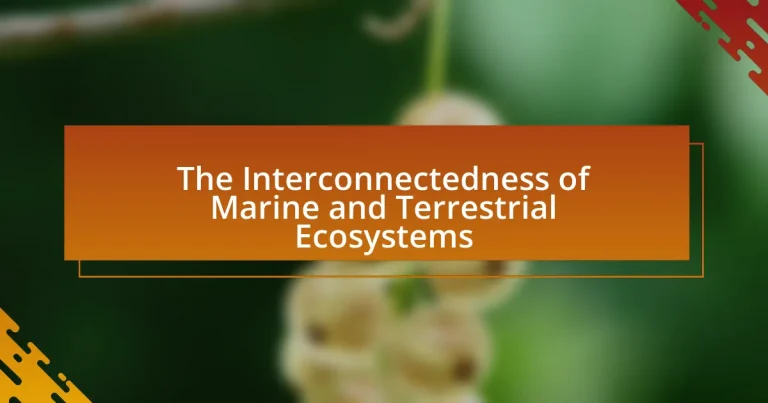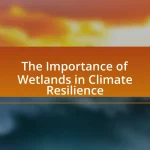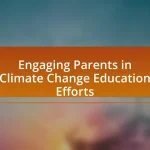The interconnectedness of marine and terrestrial ecosystems highlights the complex relationships and exchanges between land and ocean environments, where each system influences the other. Key interactions include nutrient cycling, species migration, and energy exchange, which are vital for maintaining biodiversity and ecological balance. The article explores how terrestrial ecosystems impact marine life through nutrient runoff and habitat connectivity, while also examining the ecological benefits and threats to this interdependence, such as climate change and pollution. Additionally, it discusses conservation strategies and the role of community engagement in protecting these interconnected ecosystems, emphasizing the importance of integrated management for sustainability.

What is the Interconnectedness of Marine and Terrestrial Ecosystems?
The interconnectedness of marine and terrestrial ecosystems refers to the complex relationships and exchanges between land and ocean environments, where each system influences the other. For example, rivers transport nutrients and organic matter from terrestrial ecosystems to marine environments, supporting marine biodiversity. Conversely, marine ecosystems contribute to terrestrial systems through processes like the deposition of marine nutrients, which can enhance soil fertility. Studies indicate that approximately 90% of the world’s fisheries rely on healthy coastal ecosystems, highlighting the dependency of marine life on terrestrial inputs. This interdependence underscores the importance of integrated management strategies for both ecosystems to maintain ecological balance and sustainability.
How do marine and terrestrial ecosystems interact with each other?
Marine and terrestrial ecosystems interact primarily through nutrient cycling, species migration, and the exchange of energy. For instance, rivers transport nutrients from terrestrial environments to marine ecosystems, supporting marine life. Additionally, species such as birds and fish migrate between these ecosystems, facilitating genetic exchange and biodiversity. The interdependence is further evidenced by the impact of terrestrial runoff on coastal waters, which can lead to algal blooms that affect marine food webs. This interconnectedness highlights the importance of maintaining both ecosystems for overall ecological health.
What are the key components of marine ecosystems that influence terrestrial environments?
The key components of marine ecosystems that influence terrestrial environments include nutrient cycling, coastal vegetation, and climate regulation. Nutrient cycling in marine ecosystems, particularly through upwelling and the decomposition of organic matter, enriches coastal soils, enhancing terrestrial productivity. Coastal vegetation, such as mangroves and salt marshes, provides critical habitat for wildlife and acts as a buffer against erosion, thereby stabilizing shorelines and influencing sediment transport. Additionally, marine ecosystems play a significant role in climate regulation by sequestering carbon dioxide, which impacts atmospheric conditions and, consequently, terrestrial climate patterns. These interactions demonstrate the vital link between marine and terrestrial ecosystems, underscoring their interconnectedness.
How do terrestrial ecosystems impact marine life?
Terrestrial ecosystems significantly impact marine life through nutrient runoff, sedimentation, and habitat connectivity. Nutrients such as nitrogen and phosphorus from agricultural runoff can lead to eutrophication in coastal waters, resulting in algal blooms that deplete oxygen and harm marine organisms. Additionally, sediment from deforested or eroded terrestrial areas can smother coral reefs and disrupt marine habitats. Furthermore, the connectivity between terrestrial and marine ecosystems, such as estuaries and mangroves, provides critical nursery habitats for many marine species, enhancing biodiversity and supporting fisheries. These interactions illustrate the vital role terrestrial ecosystems play in maintaining the health and stability of marine environments.
Why is understanding this interconnectedness important?
Understanding the interconnectedness of marine and terrestrial ecosystems is crucial because it highlights how changes in one environment can significantly impact the other. For instance, nutrient runoff from agricultural practices on land can lead to algal blooms in marine environments, which deplete oxygen and harm aquatic life. Research by the National Oceanic and Atmospheric Administration (NOAA) indicates that over 50% of coastal waters in the United States are affected by nutrient pollution, demonstrating the direct link between terrestrial activities and marine health. This understanding is essential for effective environmental management and conservation strategies, ensuring the sustainability of both ecosystems.
What ecological benefits arise from the relationship between marine and terrestrial ecosystems?
The relationship between marine and terrestrial ecosystems provides significant ecological benefits, including nutrient cycling, habitat provision, and biodiversity enhancement. Nutrient cycling occurs as terrestrial runoff delivers organic matter and nutrients to coastal waters, supporting marine productivity. For instance, coastal wetlands filter pollutants and contribute nutrients that sustain fish populations, which are vital for both ecosystems. Additionally, mangroves and salt marshes serve as critical habitats for various species, offering breeding grounds and shelter that enhance biodiversity. Research indicates that these ecosystems support over 75% of the world’s fish species at some stage of their life cycle, demonstrating their importance in maintaining ecological balance.
How does this interconnectedness affect biodiversity?
Interconnectedness between marine and terrestrial ecosystems significantly enhances biodiversity by facilitating species interactions and genetic exchange. This relationship allows for nutrient cycling, where nutrients from terrestrial runoff support marine life, while marine organisms contribute to terrestrial ecosystems through processes like pollination and seed dispersal. For instance, coastal wetlands serve as critical habitats for both marine and terrestrial species, supporting diverse populations and enhancing ecosystem resilience. Studies have shown that ecosystems with strong interconnections exhibit higher species richness and stability, as seen in regions where mangroves and coral reefs coexist, providing habitats for numerous species and promoting ecological balance.
What are the major threats to the interconnectedness of these ecosystems?
The major threats to the interconnectedness of marine and terrestrial ecosystems include climate change, pollution, habitat destruction, and invasive species. Climate change alters temperature and precipitation patterns, affecting both land and sea life; for instance, rising ocean temperatures lead to coral bleaching, which disrupts marine biodiversity. Pollution, such as plastic waste and agricultural runoff, contaminates both marine and terrestrial environments, harming wildlife and degrading habitats. Habitat destruction, driven by urbanization and deforestation, fragments ecosystems and disrupts the natural flow of species between land and sea. Invasive species can outcompete native species, further destabilizing these interconnected systems. These threats collectively undermine the resilience and functionality of ecosystems, as evidenced by studies showing declines in biodiversity and ecosystem services across affected areas.
How do climate change and pollution disrupt these interactions?
Climate change and pollution disrupt the interactions between marine and terrestrial ecosystems by altering habitat conditions and degrading water quality. Rising temperatures from climate change lead to ocean acidification and altered salinity levels, which negatively impact marine species and their ability to thrive. For instance, coral reefs, which serve as critical habitats for numerous marine organisms, are severely affected by increased sea temperatures, resulting in coral bleaching and loss of biodiversity.
Pollution, particularly from agricultural runoff and plastic waste, introduces harmful chemicals and toxins into marine environments, further degrading water quality and harming aquatic life. Studies show that nutrient pollution can lead to harmful algal blooms, which deplete oxygen levels and create dead zones, making it difficult for marine species to survive. Additionally, pollutants can bioaccumulate in the food chain, affecting both marine and terrestrial organisms that rely on these ecosystems for sustenance.
These disruptions illustrate the fragile balance between marine and terrestrial ecosystems and highlight the urgent need for integrated environmental management strategies to mitigate the impacts of climate change and pollution.
What role does habitat destruction play in this context?
Habitat destruction significantly disrupts the interconnectedness of marine and terrestrial ecosystems by diminishing biodiversity and altering ecological balance. When habitats such as forests, wetlands, and coral reefs are destroyed, species that rely on these environments for survival face extinction, leading to a decline in ecosystem services. For instance, the loss of mangroves, which serve as critical nurseries for marine life, directly impacts fish populations and, consequently, the fishing industry. According to the World Wildlife Fund, approximately 50% of mangrove forests have been lost globally, highlighting the urgent need to address habitat destruction to maintain the health of both marine and terrestrial ecosystems.
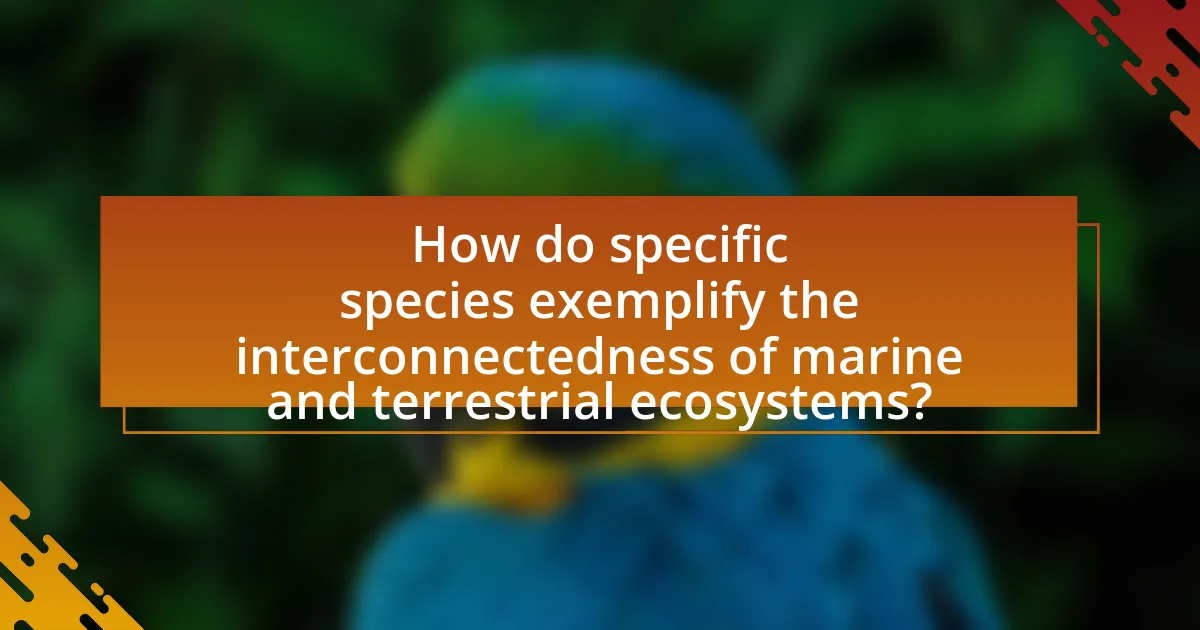
How do specific species exemplify the interconnectedness of marine and terrestrial ecosystems?
Specific species, such as sea turtles and migratory birds, exemplify the interconnectedness of marine and terrestrial ecosystems through their life cycles and feeding habits. Sea turtles, for instance, contribute to the health of seagrass beds in marine environments by grazing on seagrass, which promotes growth and provides habitat for other marine species. Additionally, when these turtles nest on beaches, they deposit nutrient-rich eggshells that enhance the terrestrial ecosystem’s nutrient profile.
Migratory birds, like the Arctic tern, connect these ecosystems by feeding on fish in marine environments and then nesting on land, where they contribute to soil fertility through their droppings. Research indicates that the nutrient transfer from marine to terrestrial ecosystems via these species supports biodiversity and ecosystem productivity. This interdependence highlights how specific species serve as vital links between marine and terrestrial environments, reinforcing the concept of ecological connectivity.
What are some examples of species that thrive in both environments?
Some examples of species that thrive in both marine and terrestrial environments include the mangrove tree, the saltwater crocodile, and certain species of amphibians like the bullfrog. Mangrove trees are adapted to grow in coastal intertidal zones, where they can withstand both saltwater and freshwater conditions. Saltwater crocodiles inhabit both freshwater rivers and saltwater estuaries, showcasing their adaptability to different aquatic environments. Bullfrogs can live in freshwater habitats and are also found in areas close to saltwater, demonstrating their ability to thrive in diverse ecosystems.
How do migratory patterns illustrate the connection between marine and terrestrial ecosystems?
Migratory patterns illustrate the connection between marine and terrestrial ecosystems by demonstrating how species rely on both environments for survival and reproduction. For example, many bird species migrate between coastal marine areas and inland habitats, utilizing resources from both ecosystems during different life stages. The Arctic Tern, which migrates from the Arctic to the Antarctic, relies on marine food sources during its journey and nesting sites on land, highlighting the interdependence of these ecosystems. Additionally, salmon migrate from freshwater rivers to the ocean and back, playing a crucial role in nutrient transfer between marine and terrestrial environments, as their spawning enriches river ecosystems with marine-derived nutrients. This evidence underscores the vital links between migratory species and the health of both marine and terrestrial ecosystems.
What role do keystone species play in maintaining this interconnectedness?
Keystone species play a critical role in maintaining the interconnectedness of marine and terrestrial ecosystems by significantly influencing the structure and function of their environments. These species, such as sea otters in marine ecosystems or wolves in terrestrial ecosystems, help regulate populations of other species, thereby maintaining biodiversity and ecosystem stability. For instance, the presence of sea otters controls sea urchin populations, which in turn allows kelp forests to thrive, supporting various marine life. This dynamic illustrates how the removal of a keystone species can lead to dramatic shifts in ecosystem balance, demonstrating their essential role in fostering interdependence among species across both marine and terrestrial environments.
How do food webs illustrate the interconnectedness of these ecosystems?
Food webs illustrate the interconnectedness of ecosystems by demonstrating how energy and nutrients flow between various organisms within both marine and terrestrial environments. In these webs, producers, such as plants and phytoplankton, serve as the foundation, supporting herbivores and subsequently carnivores, creating a complex network of relationships. For instance, the transfer of energy from a terrestrial plant to a herbivore, which may then be consumed by a carnivore, highlights the dependency of species across different habitats. Additionally, studies show that disruptions in one part of the food web, such as the decline of a key species, can have cascading effects throughout the entire ecosystem, affecting both marine and terrestrial life. This interconnectedness is crucial for maintaining biodiversity and ecosystem stability.
What are the primary food sources that link marine and terrestrial food webs?
The primary food sources that link marine and terrestrial food webs include fish, marine mammals, and seabirds, which transfer energy and nutrients between these ecosystems. For instance, fish such as salmon migrate from freshwater to marine environments and are consumed by terrestrial predators, including bears and eagles. Additionally, marine mammals like seals can be preyed upon by terrestrial carnivores, while seabirds often feed on marine organisms and nest on land, contributing nutrients to terrestrial ecosystems through their droppings. These interactions illustrate the flow of energy and nutrients across ecosystem boundaries, highlighting the interconnectedness of marine and terrestrial food webs.
How do changes in one ecosystem affect the food web of the other?
Changes in one ecosystem can significantly impact the food web of another due to interconnected ecological relationships. For instance, alterations in a terrestrial ecosystem, such as deforestation, can lead to increased runoff and sedimentation in nearby marine environments, affecting the availability of nutrients and light for aquatic plants. This disruption can cascade through the food web, impacting herbivores that rely on these plants and subsequently affecting predators higher up the food chain. Research has shown that nutrient loading from terrestrial sources can lead to algal blooms in marine ecosystems, which deplete oxygen and harm marine life, illustrating the direct link between terrestrial changes and marine food webs.
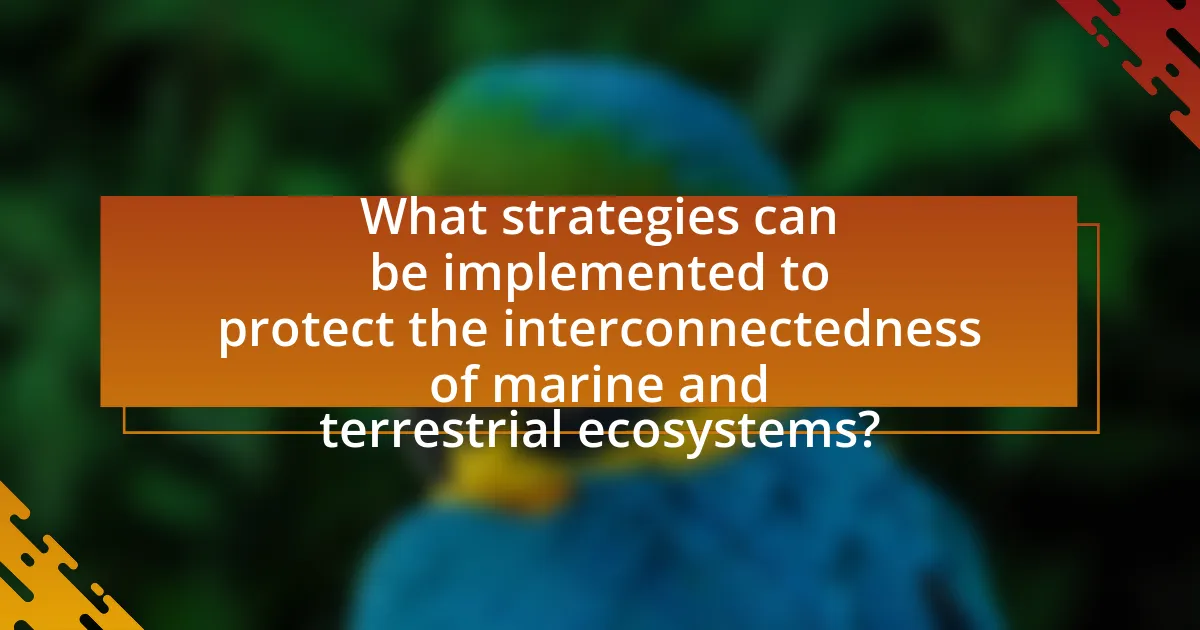
What strategies can be implemented to protect the interconnectedness of marine and terrestrial ecosystems?
To protect the interconnectedness of marine and terrestrial ecosystems, implementing integrated land and water management strategies is essential. These strategies include establishing protected areas that encompass both marine and terrestrial environments, which can enhance biodiversity and ecosystem resilience. For instance, the establishment of marine protected areas (MPAs) alongside terrestrial reserves has been shown to improve species diversity and habitat connectivity, as evidenced by studies indicating that MPAs can lead to a 20-50% increase in fish populations and overall marine biodiversity. Additionally, promoting sustainable agricultural practices that reduce runoff and pollution entering marine environments can further safeguard these ecosystems. Research has demonstrated that practices such as buffer strips and organic farming can significantly decrease nutrient loading in coastal waters, thereby protecting marine life. Furthermore, fostering community engagement and education about the importance of ecosystem interdependence can lead to more effective conservation efforts.
What conservation efforts are currently in place to support this interconnectedness?
Conservation efforts currently in place to support the interconnectedness of marine and terrestrial ecosystems include the establishment of marine protected areas (MPAs) and integrated coastal zone management (ICZM). MPAs help preserve biodiversity and protect critical habitats that link land and sea, while ICZM promotes sustainable development by coordinating the management of coastal resources. For instance, the United Nations Environment Programme reports that over 7% of the world’s oceans are now designated as MPAs, which aids in maintaining ecological balance and supporting species migration between ecosystems. Additionally, initiatives like the Blue Carbon Project focus on conserving coastal ecosystems such as mangroves and salt marshes, which sequester carbon and provide habitat for both marine and terrestrial species, further emphasizing the importance of these conservation strategies.
How can policy changes enhance the protection of these ecosystems?
Policy changes can enhance the protection of marine and terrestrial ecosystems by implementing stricter regulations on pollution and habitat destruction. For instance, the establishment of marine protected areas (MPAs) has been shown to increase biodiversity and fish populations, as evidenced by a study published in the journal “Nature” which found that MPAs can lead to a 20-50% increase in fish biomass within their boundaries. Additionally, policies that promote sustainable land use practices can reduce runoff and habitat degradation, thereby protecting both marine and terrestrial ecosystems. The integration of ecosystem-based management approaches, which consider the interconnectedness of these ecosystems, can further strengthen conservation efforts by ensuring that policies address the cumulative impacts of human activities across both environments.
What role does community engagement play in conservation efforts?
Community engagement plays a crucial role in conservation efforts by fostering local stewardship and enhancing the effectiveness of conservation initiatives. Engaged communities are more likely to participate in sustainable practices, monitor local ecosystems, and advocate for policies that protect their environment. Research indicates that when communities are involved in conservation planning and decision-making, projects are more successful; for example, a study published in the journal “Conservation Biology” found that community-led initiatives in marine protected areas resulted in improved biodiversity outcomes and increased compliance with regulations. This demonstrates that active participation not only empowers local populations but also leads to more resilient ecosystems, highlighting the interconnectedness of human and ecological health.
What best practices can individuals adopt to support the health of both ecosystems?
Individuals can adopt several best practices to support the health of both marine and terrestrial ecosystems, including reducing plastic use, conserving water, and promoting biodiversity. Reducing plastic use minimizes pollution in oceans and waterways, which directly impacts marine life; for instance, studies show that over 8 million tons of plastic enter oceans annually, harming marine species. Conserving water helps maintain the balance of freshwater ecosystems, as excessive water withdrawal can lead to habitat degradation. Additionally, promoting biodiversity through native plant gardening and supporting local wildlife can enhance ecosystem resilience, as diverse ecosystems are better equipped to withstand environmental changes. These practices collectively contribute to the sustainability of interconnected ecosystems.
How can sustainable practices in agriculture benefit marine ecosystems?
Sustainable practices in agriculture can significantly benefit marine ecosystems by reducing nutrient runoff and chemical pollution. When farmers implement techniques such as crop rotation, cover cropping, and organic farming, they enhance soil health and minimize the use of synthetic fertilizers and pesticides. This leads to lower levels of nitrogen and phosphorus entering waterways, which are primary contributors to harmful algal blooms that deplete oxygen in marine environments. For instance, the Chesapeake Bay Program reported that implementing sustainable agricultural practices has led to a 30% reduction in nutrient runoff, positively impacting the bay’s water quality and marine life. Thus, sustainable agriculture directly contributes to healthier marine ecosystems by mitigating pollution and promoting biodiversity.
What actions can be taken to reduce pollution affecting both environments?
To reduce pollution affecting both marine and terrestrial environments, implementing stricter regulations on industrial emissions is essential. These regulations can limit the release of harmful pollutants into the air and water, thereby protecting both ecosystems. For instance, the Clean Air Act and Clean Water Act in the United States have significantly reduced pollutants, leading to improved air and water quality. Additionally, promoting sustainable agricultural practices, such as reducing pesticide and fertilizer use, can minimize runoff that contaminates waterways and harms marine life. Studies show that adopting integrated pest management can reduce chemical use by up to 50%, benefiting both land and aquatic ecosystems. Furthermore, increasing public awareness and community involvement in clean-up initiatives can foster a culture of environmental stewardship, leading to reduced litter and pollution in both environments.
